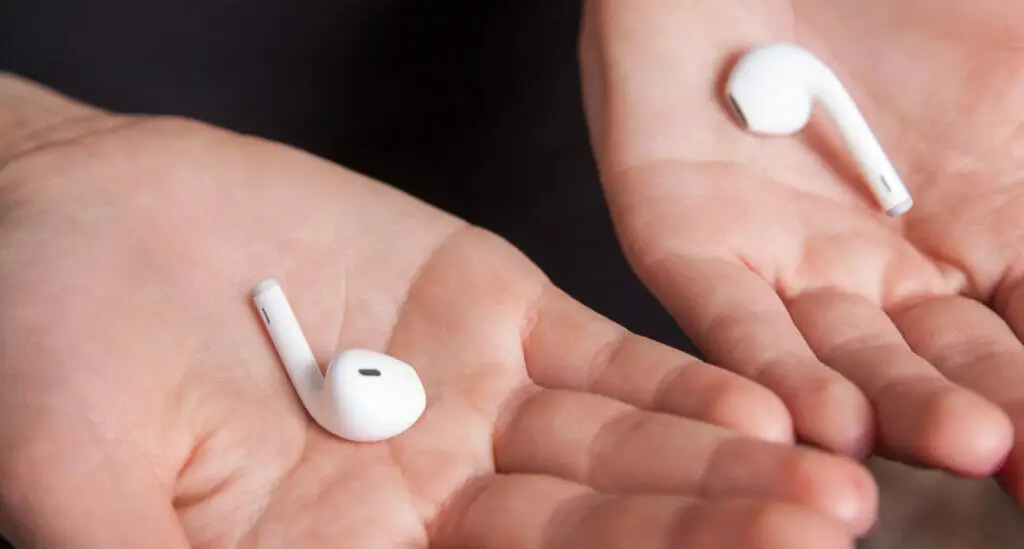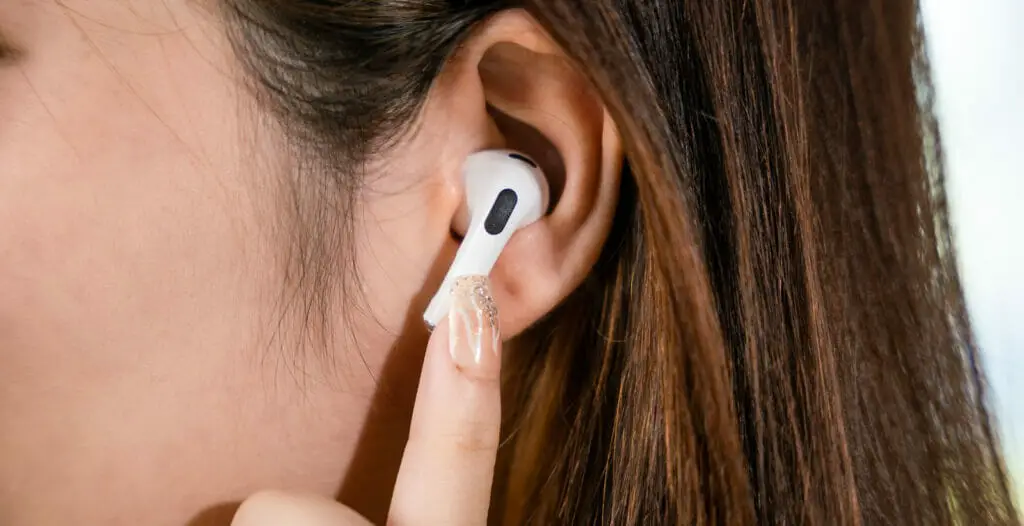Ever wondered how wireless earbuds work? In this article, we’ll delve into the workings of wireless earbuds, giving you a glimpse into the world behind the magic.
Key Takeaways: Wireless earbuds work through Bluetooth technology, utilizing radio waves to connect and transmit audio from a device, such as a smartphone or tablet, to the earbuds. They operate in a specific range of radio frequencies, around 2.4 GHz, to avoid interference with other electronic devices. Some earbuds use Near Field Magnetic Induction (NFMI), which offers more energy-efficient and stable connections.
Ready to learn more? Stick around, and I’ll guide you through the science and the intricacies of wireless earbuds in an easy-to-understand manner.
How Wireless Earbuds Work
Bluetooth Technology

First, Bluetooth is a convenient wireless communication protocol that allows two compatible devices to connect and share data.
In the case of wireless earbuds, they use this technology to connect to devices like smartphones or tablets. Unlike wired earbuds that rely on a physical connection, these wireless wonders communicate using radio waves similar to radios and walkie-talkies.
What makes Bluetooth technology even more fascinating is how it manages connections between multiple devices. Your wireless earbuds usually connect to one primary device, say your phone.
But did you know that some advanced earbuds can even be connected to more than one device simultaneously? That’s the magic of Bluetooth.
The Bluetooth signal might sometimes face interference as we move around with our earbuds, especially in crowded places. But fret not; Bluetooth protocols have been developed to be robust, ensuring that our music keeps playing without significant disruptions.
So, next time you pop in your wireless earbuds, take a moment to appreciate the amazing Bluetooth technology that makes it all possible. It’s a convenience and testament to how far we’ve come in wireless communication.
Radio Frequency
Let me tell you about radio frequency and how it plays a crucial role in working wireless earbuds. You see, wireless earbuds operate by transmitting audio information through radio signals.
These signals are similar to how traditional FM radios broadcast sound, allowing an uninterrupted audio flow from one device to another.
It’s important to understand that wireless earbuds use a specific range of radio frequencies, usually around 2.4 GHz, to ensure the smoothest connection between devices.
What’s great about this is that it minimizes interference with other electronic devices in the vicinity, making it pretty unlikely for us to experience any annoying audio dropouts or distortion.
You might wonder how these wireless earbuds stay connected even when moving around the room or running.
With a typical range of up to 30 feet, you can freely move around without worrying about losing your connection, making it super convenient for everyday use.
As such, radio frequency plays a significant role in making wireless earbuds a fantastic innovation. It’s amazing how this technology allows us to enjoy our favorite tunes and take calls without the hassle of pesky wires getting in the way!
Near Field Magnetic Induction (NFMI)
NFMI is a game-changer regarding efficiency and comfort in wireless audio and data streaming. Let me explain how it works.
Unlike Bluetooth, which sends signals over greater distances and can waste power, NFMI is much more energy-efficient.
The magnetic fields used for data transmission have a low absorption rate, meaning the signal can penetrate human tissue without losing strength, which is 100 times lower than Bluetooth. It’s also safer because the Specific Absorption Rate (SAR) is significantly reduced.
NFMI is quite similar to how conventional wired earbuds send sound — but instead of electrical currents, it uses magnetic fields to transmit audio signals.
One big advantage of NFMI is that it enables a secure and stable connection between earbuds since the magnetic fields are strong enough to pass through the human body without interruption.
One thing I noticed while using NFMI-enabled wireless earbuds is that the audio quality remains crisp and clear due to the pure audio transmission. It’s almost like I’m wearing wired earbuds without the tangled mess of cords!
Hardware Components of Wireless Earbuds
Components of Wireless Earbuds
| Component | Description |
|---|---|
| Drivers | The tiny speakers inside each earbud that turns electrical signals into the sound we hear. |
| Amplifier | Boosts the audio signal before it reaches the drivers, enhancing the sound volume. |
| Antenna | Built into the earbuds, it picks up Bluetooth radio waves from your device. |
| Microphones | Allow users to make calls, interact with voice assistants, or control playback. |
| Codecs | Determine the quality of the sound being transmitted, through the compression and decompression of digital audio. |

Drivers and Sound Quality
In my experience with wireless earbuds, the key to excellent sound quality lies in the drivers. A driver is a tiny speaker inside each earbud that turns electrical signals into the sound we hear.
Typically, there are two types of drivers: dynamic and balanced armature. Dynamic drivers offer a more powerful and expansive sound, while balanced armature drivers provide greater precision and accuracy. Different earbuds use different driver combinations to achieve their unique sound signature.
They work hand in hand with the codec – the technology that compresses and decompresses digital audio.
You might have come across names like aptX, AAC, or SBC – just some codecs that help deliver audio from your device to your wireless earbuds. You’ll learn more about this later in the article.
The amplifier is another crucial component. It helps to boost the audio signal before it reaches the drivers, making the sound loud enough for us to enjoy our favorite tunes without distortion.
Antenna and Radio Waves
Now, how do these tiny earbuds receive audio signals without any wires? It’s all thanks to the antenna and radio waves. Wireless earbuds usually have a tiny built-in antenna designed to pick up Bluetooth radio waves from your device, like your smartphone or laptop.
These radio waves carry your music data from the device to the earbuds, which the drivers convert into sound. This incredible technology allows us to free ourselves from tangled cords and enjoy music on the go.
The key to maintaining a stable connection and high-quality audio lies in good antenna design within the earbuds, ensuring they can effectively receive those radio waves even while in motion or at a distance from the device.
As such, those basic hardware components help wireless earbuds deliver amazing sound quality and freedom from wires.
Microphones and Amplifiers
We can’t forget about phone calls and voice commands! Most wireless earbuds have built-in microphones that allow users to make calls, interact with voice assistants, or control playback.

These microphones are usually omnidirectional, providing decent audio input in various environments. To amplify the audio, as mentioned, earbuds consist of amplifiers that boost weak audio signals, enhancing the overall audio experience.
Codecs and Compression
Let’s discuss the different audio formats and their role in wireless earbuds. Digital audio files need to be compressed for wireless audio to work efficiently.
This is done using various codecs, determining the sound quality being transmitted. Some popular codecs include the aptX, AAC, and SBC codecs.
| Codec | Description |
|---|---|
| aptX | This codec, developed by Qualcomm, delivers 24-bit wireless audio over Bluetooth. It’s designed to improve the signal-to-noise ratio, reducing background noise and letting you enjoy your music as intended to be heard. Honestly, this codec is fantastic for Android users! |
| AAC | This codec can provide higher sound quality for listeners. Apple devices mostly use it, which works exceptionally well with iOS products. You’ll likely benefit from this codec if you’re an iPhone user like me. |
| SBC | The standard Bluetooth codec is SBC or Subband Coding. Although it may not provide the absolute best sound quality, it’s the most common codec found in Bluetooth devices. It does a decent job of balancing audio quality and file size, ensuring your wireless earbuds work effectively. |
Isn’t it amazing how our wireless earbuds can pack so much technology in such a small package? We can enjoy great music without the hassle of wires, and it’s all thanks to clever audio transmission methods combined with these codecs and compression!
Noise Cancellation and Sound Isolation

Active Noise Cancellation (ANC)
In my experience with wireless earbuds, Active Noise Cancellation (ANC) is a game-changer. Who doesn’t want to block out distracting noises while jamming to their favorite tunes? ANC uses tiny microphones built into the earbuds to pick up external sounds.
| Mechanism | Description |
|---|---|
| Active Noise Cancellation (ANC) | Uses microphones built into the earbuds to pick up external sounds and produces an opposite sound wave to cancel it out. |
| Passive Sound Isolation | Creates a physical barrier between your ear canal and the outside world, essentially working as an earplug. |
The earbuds create an equal but opposite sound wave, eliminating unwanted noise. This way, you and your playlist are just without the background chaos.
The effectiveness of ANC, however, depends on the earbuds themselves and how well they’re designed. For instance, ANC works best at blocking constant, low-frequency noises – like the hum of an airplane engine or a noisy air conditioning unit.
It might struggle with sudden, high-frequency noises like someone slamming a door. And, of course, a snug fit in your ear is essential for ANC to work its magic.
Passive Sound Isolation
Now, let’s talk about Passive Sound Isolation. While not as high-tech as ANC, it has its charm. It’s all about creating a physical barrier between your ear canal and the outside world. Think of it like earplugs but way more comfortable, stylish, and fun!
Passive Sound Isolation is achieved through the earbuds’ or ear cups’ design and materials. Creating a tight seal around your ear or within your ear canal, these earbuds help keep external sounds out and your music in. This is particularly effective for blocking mid and high-frequency noises.
Of course, not all earbuds with Passive Sound Isolation are created equal. Some materials and designs are better at forming that perfect seal than others. Finding the right fit for your ears is crucial because it ensures a secure barrier around your ear canal.
Potential Interference and Alternative Technologies
Potential Issues with Wireless Earbuds
| Issue | Description |
|---|---|
| Radio Signals Interference | Wireless earbuds can face interference due to other devices operating in the same radio frequency range. |
| Inefficient Energy Use | Traditional Bluetooth can waste power when transmitting signals over greater distances. |
| Connection Disruptions | Movements and distance from the connected device can potentially disrupt the Bluetooth connection. |
Radio Signals Interference
As someone who appreciates great audio, I’ve noticed that wireless earbuds sometimes face interference. One of the culprits for this issue is radio signals.
Bluetooth technology, commonly used in wireless earbuds, shares the same band of radio frequencies as other devices like microwaves and Wi-Fi routers. When these devices operate simultaneously, interference can occur, affecting the audio quality of your earbuds.
Wireless devices have come a long way, but it’s important to understand that radio signal interference is just one of those annoyances we sometimes have to deal with.
I’ve been there – rocking out to my favorite tunes when, suddenly, the connection gets choppy. It’s frustrating, but thankfully, some alternative technologies might be the solution.
Near Field Magnetic Induction (NFMI)
One of those promising alternatives is Near Field Magnetic Induction (NFMI). Unlike Bluetooth, as discussed above, NFMI doesn’t rely on radio signals but instead uses magnetic fields to transmit audio.
This technology is fascinating because it can reduce the interference we experience with our wireless earbuds.
Understanding the potential issues of radio signal interference is important, but I’m excited about the possibilities that alternative technologies like NFMI bring. With these innovations on the horizon, we can look forward to even better audio experiences with our wireless earbuds.
References
Organizations:
- Bluetooth Special Interest Group (SIG). https://www.bluetooth.com/
Books:
- “The Science and Applications of Acoustics” by Daniel R. Raichel
- “The Master Handbook of Acoustics” by F. Alton Everest, Ken C. Pohlmann
- “Principles of Digital Audio” by Ken C. Pohlmann
Websites:
- CNET. https://www.cnet.com/
- PCMag. https://www.pcmag.com/

